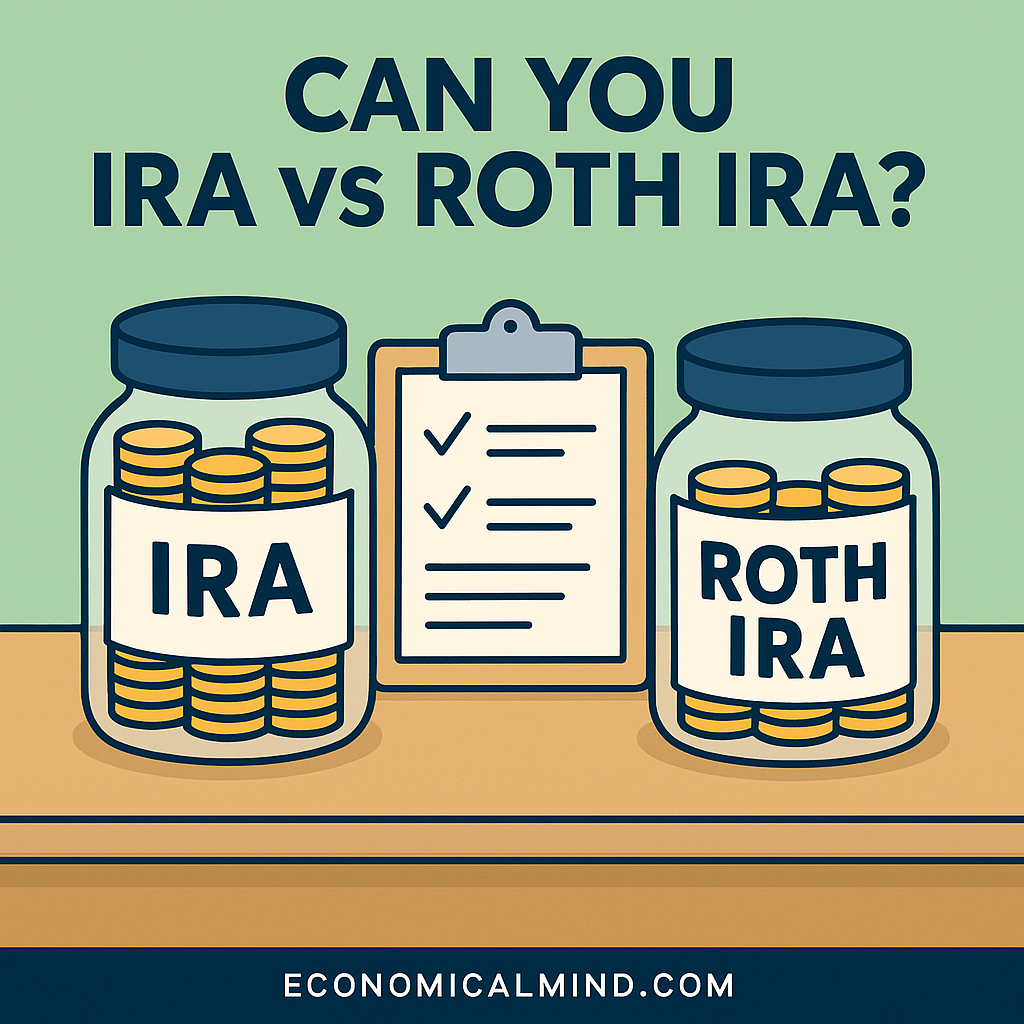
If you’re saving for retirement, you’ve likely heard about IRAs — and maybe wondered what the difference is between a Traditional IRA and a Roth IRA. Both help you grow retirement savings with tax advantages, but they work in opposite ways. Understanding which one fits your situation can save you thousands over time.
What Is an IRA?
An IRA (Individual Retirement Account) is a personal savings account that lets you invest for retirement with special tax benefits. You can open one through a bank, brokerage, or robo-advisor and contribute up to $7,000 per year (or $8,000 if you’re 50 or older, as of 2025).
IRAs help you grow your money through stocks, bonds, ETFs, or mutual funds — all while offering tax advantages depending on the type you choose.
Traditional IRA vs Roth IRA: The Core Difference
The main difference is when you pay taxes:
- Traditional IRA: Pay taxes later — contributions are tax-deductible now, but withdrawals in retirement are taxed.
- Roth IRA: Pay taxes now — contributions are made with after-tax dollars, but withdrawals in retirement are tax-free.
Example:
If you’re in a high tax bracket now but expect to be in a lower one later, a Traditional IRA makes sense. If you expect higher taxes in the future, a Roth IRA can save you money in the long run.
Pros of a Traditional IRA
1. Immediate Tax Deduction
Your contributions may lower your taxable income this year.
Example: Contributing $6,000 could reduce your taxable income by the same amount.
2. Flexible Investment Choices
You can invest in a wide variety of assets for long-term growth.
3. Ideal for High Earners Today
If you expect to retire in a lower tax bracket, you’ll likely pay less tax later.
4. No Income Limits for Contributions
Anyone with earned income can contribute (though tax deductibility may phase out at higher incomes).
5. Possible Employer Rollovers
You can roll over 401(k) funds into a Traditional IRA when changing jobs.
Cons of a Traditional IRA
1. Taxes on Withdrawals
All withdrawals are taxed as regular income in retirement.
Fix: Plan for smaller distributions to reduce tax impact.
2. Early Withdrawal Penalties
Taking money out before age 59½ triggers taxes and a 10% penalty.
Fix: Leave funds untouched unless it’s a qualified exception.
3. Required Minimum Distributions (RMDs)
You must start withdrawals at age 73.
Fix: Convert some funds to a Roth before RMDs begin.
Pros of a Roth IRA
1. Tax-Free Withdrawals
Your money grows tax-free, and you pay no taxes on qualified withdrawals.
2. No RMDs
You can leave your money invested as long as you want — great for estate planning.
3. Flexible Access to Contributions
You can withdraw your contributions (not earnings) anytime without penalty.
4. Ideal for Younger or Lower-Income Earners
If your tax rate is low now, paying taxes upfront can save you money later.
5. Easier Inheritance Rules
Beneficiaries receive tax-free distributions under most conditions.
Cons of a Roth IRA
1. No Immediate Tax Break
You don’t get a tax deduction now, which may be a drawback for high earners.
2. Income Limits
High-income earners may be restricted from contributing directly.
Fix: Use a “backdoor” Roth conversion if eligible.
3. Contribution Limits
Annual contribution caps apply to both types combined — you can’t exceed $7,000 total.
4. Must Be Open 5 Years Before Withdrawals
To withdraw earnings tax-free, your account must be at least five years old.
5. Future Tax Changes Could Shift Benefits
Tax laws evolve — always keep an eye on updates.
Best Practices for Choosing Between a Traditional and Roth IRA
1. Consider Your Current vs Future Tax Bracket
If you expect higher taxes later, Roth may win. If lower, Traditional may fit better.
2. Use Both Strategically
You can split contributions between the two for tax diversification.
3. Max Out Employer Matches First
If you have a 401(k) match, prioritize that before IRA contributions.
4. Start Early
The sooner you start, the more time your investments have to grow tax-advantaged.
5. Automate Contributions
Set up automatic monthly transfers to stay consistent.
6. Revisit Yearly
Review your income, tax situation, and goals annually.
7. Don’t Withdraw Early
Treat your IRA as untouchable until retirement unless it’s a qualified need.
8. Explore Conversions
If your income dips, converting Traditional IRA funds to Roth can save future taxes.
Key Takeaway
Both Traditional and Roth IRAs help you save for retirement — they just take different tax paths. Understanding how and when you’ll be taxed helps you choose the right one for your goals.
